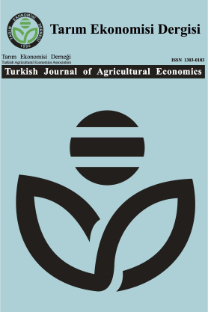Türkiye’de Çok Boyutlu Kırsal Yoksulluk
Çok Boyutlu Kırsal Yoksulluk, Türkiye
Multidimensional Rural Poverty In Turkey
Multidimensional Rural Poverty, Turkey,
___
- ACAR, A. & BAŞLEVENT, C. 2014. Examination of the Transition of Households into and Out of Poverty in Turkey. Betam Working Paper Series, 15.
- ALKIRE, S. & FOSTER, J. 2011. Counting and multidimensional poverty measurement. Journal of Public Economics, 95, 476-487.
- AYTAÇ, A. & HATIPLER, M. 2013. Dünya’da ve Türkiye’de Yoksulluğun Özgün Yapısı ve Yoksullukla Mücadele, Paradigma Kitabevi Yayınları.
- BMKP 2010. Human Development Report 2010. United Nations.
- BMKP 2011. Human Development Report 2011. United Nations.
- CHANFREAU, J. & BURCHARDT, T. 2008. Equivalence scales: rationales, uses and assumptions.
- DB 1990. World Development Report 1990. The World Bank.
- DEATON, A. 2013. The Great Escape Health, Wealth, and the Origins of Inequality, New Jersey, Princeton University Press.
- FAO 2005. Equivalence Scales: General Aspects.
- FIELD, F. 1984. The Minimum Wage, London, Policy Studies Institute.
- HAGENAARS, J. M., VOS, K. D. & ZAIDI, M. A. 1994. Poverty Statistics in the Late 1980s: Research. Based on Micro-data. Luxembourg.
- HAUGHTON, J. & KHANDKER, S. R. 2009. Handbook on Poverty and Inequality, Washington, DC, The World Bank.
- ILO. 2015. Labour Market Impact of Syrians and their Employability [Online]. Available: http://www.ilo.org/ankara/news/WCMS_440085/lang--en/index.htm [Accessed 08.22. 2017].
- KARADAĞ, M. A. 2015. Tek boyutlu ve Çok Boyutlu Yoksulluk Ölçümleri: Türkiye Uygulaması. PhD, GAZİ UNIVERSITY.
- OECD 2012. What are Equivalence Scales?
- RIO GROUP 2006. Compendium of Best Practices in Poverty Measurement.
- RODRIK, D. 2012. The Globalization Paradox, W.W. Norton & Company.
- SEN, A. 1992. inequality reexamined. Oxford University Press.
- SEN, A. 1999. Development as Freedom, New York, Alfred A. Knopf.
- ŞENSES, F. 2001. Küreselleşmenin Öteki Yüzü: Yoksulluk, İstanbul, tletişim Yayınlan.
- TBMM 2012. 6360 sayılı On Üç İlde Büyükşehir Belediyesi ve Yirmi Altı İlçe Kurulması ile Bazı Kanun ve Kanun Hükmünde Kararnamelerde Değişiklik Yapılmasına Dair Kanun
- TCMB. 2018. Elektronik Veri Dağıtım Sistemi [Online]. Available: https://evds2.tcmb.gov.tr/ [Accessed 10.07.2018].
- TUİK. 2018. Yapı İzin İstatistikleri [Online]. Available: http://www.tuik.gov.tr/PreTablo.do?alt_id=1055 [Accessed 10.07.2018].
- UĞUR, M. S. 2015. Yoksulluğun Çok Boyutluluğu ve Türkiye için Çok Boyutlu Bir Yoksulluk Ölçümü. EY International Congress on Economics II "Growth, Inequality and Poverty".
- ZEUMO, V. K., SOME, B. & TSOUKIÀS, A. 2011. A survey on Multidimensional Poverty Measurement: a Decision Aiding Perspective.
- ISSN: 1303-0183
- Yayın Aralığı: 2
- Başlangıç: 1992
- Yayıncı: Tarım Ekonomisi Dergisi
Türkiye’de Çok Boyutlu Kırsal Yoksulluk
Burak ÖZTORNACI, Haydar ŞENGÜL
Afganistan Tarım Ürünleri Dış Ticaret Yapısına İlişkin Bir Değerlendirme
Mohammad Sharf RAHİMİ, M. Metin ARTUKOĞLU
Su Kaynaklarının Korunmasında Yerel Tohum Çeşitlerinin Rolü Üzerine Çiftçi Görüşleri
H.Ece SALALI, Ela ATIŞ, Cihat GÜNDEN
Zeytinyağ Sektöründe Çapraz Ülke Etkinliği: İtalya-Türkiye
Altuğ ÖZDEN, Maurzo PROSPERI, Rafaela DIOS-PALOMARES, Armando URSITTI
Çiftçilerin Kooperatifçiliğe Bakış Açıları Üzerine Bir Araştırma: Ağrı Ve Eskişehir İlleri Örneği
Necat KAYA, Sultan ÇOKER, Filiz KINIKLI, Murat YERCAN
Türkiye’nin Kuru Üzüm Dış Satım Potansiyelinin Çekim Modeli İle İncelenmesi
Bazı Ülkelerde ve Türkiye’de Bankaların Tarımsal Kredi Uygulamalarının Analizi
İpek TOPUZOĞLU, M. Metin ARTUKOĞLU
Türkiye Organik İncir İhraç Fiyatının Arma Yöntemi İle Tahmini
Tarife Dışı Engellerin Türkiye’nin Tarım Ürünleri Dış Ticaretine Olan Etkisi
Osman Orkan ÖZER, Betül GÜRER, Berrin TAŞKAYA TOP, Mustafa KAN
